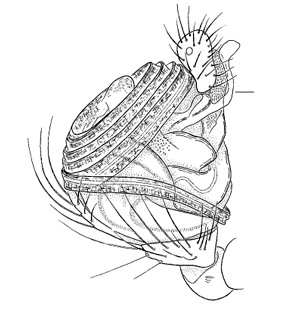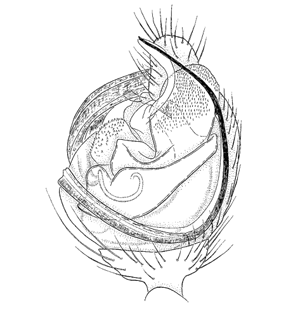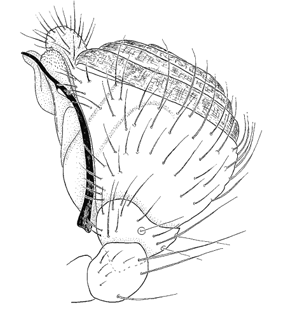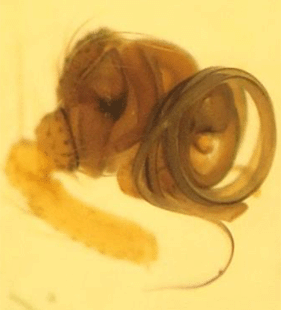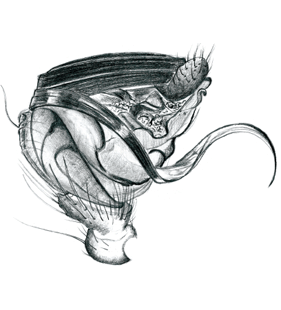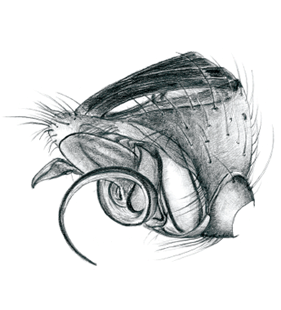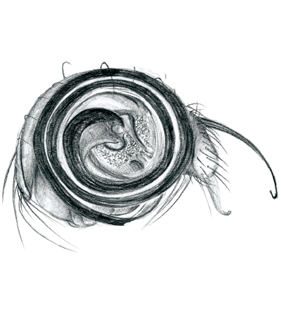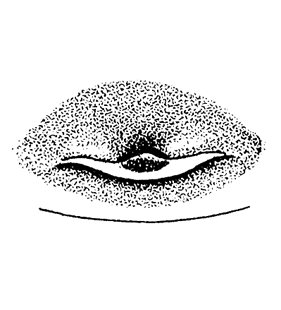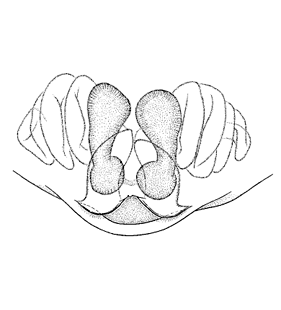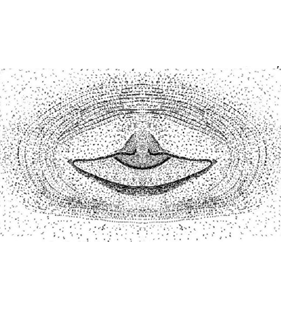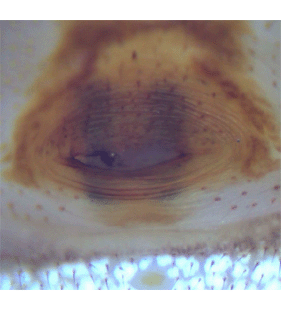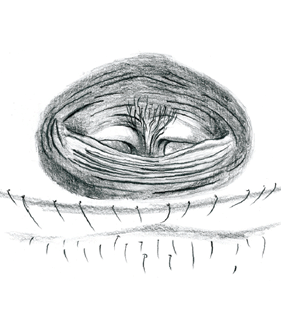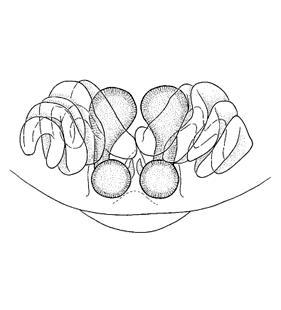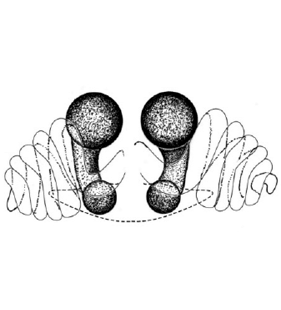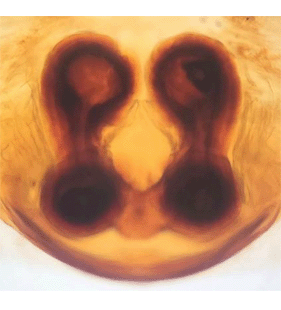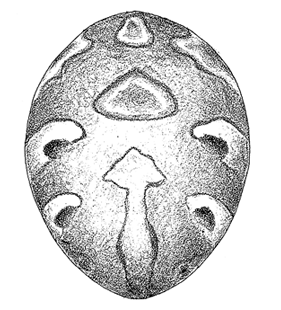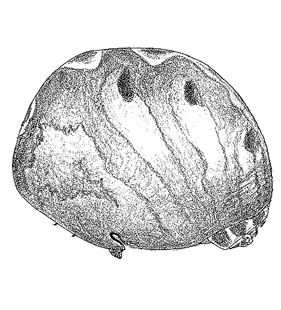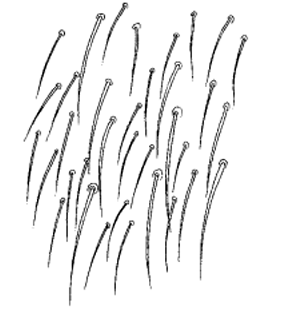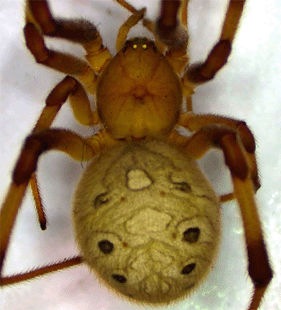Latrodectus geometricus C. L. Koch, 1841
Description
Male
Palp similar to that of L. tredecimguttatus. Prosoma 2.4 mm long. Colouration as in female, but with more contrast.
Body length male: 3.4-6.2 mmFemale
Vulva: copulatory ducts forming 4 coils, spermathecae parallel. Prosoma brown, 4.4 mm long. Legs: patella and tip of tibia darker. Opisthosoma dark brown to black, dorsally with loop-like brown blotches, ventrally with a dark red marking. Opisthosoma clothed with very long hair-like bristles.
Body length female: 8.1-13 mmAdditional information
Usually around houses, under or between stones, or on low vegetations. Altitude up to 1050 m.
This species is assumed to be less toxic than the European L. tredecimguttatus, but it can bite humans, as also all other Latrodectus species in the world. Often, a bite causes significant effects, with severe and long-lasting pain in two-thirds of cases, preventing patients from sleeping in one-third of cases. Pain increases in more than half of the cases within the first hour and mostly radiates into the limbs or abdominal pain develops. Typical symptoms include sweating in about 70% of cases and further systemic effects in 20–30% of cases (nausea and vomiting in less than 20%, raised temperature and neuromuscular effects in about 10%, hypertension in less than 10% of cases). Pain usually lasts 1–2 days and the other symptoms 1–4 days. If needed, a symptomatic medical treatment is recommended.
This species of African origin is not native to geographical Europe (alien species). Introductions to several countries did not lead to established populations but it occurs in Turkey, Cyprus and northern Africa.
Distribution
Figures
Distribution List
"No references" does not mean that the species does not occur in this country, but that we have not yet inserted the reference for it. We are working on it.
References
Abdel-Ghani D M A, Hassan F M, Sallam G M E (2023) Spiders as a bio-agent factor in a mango greenhouse at Giza Governorate, Egypt. Serket 20: 26-38 ![]()
Baert L, Maelfait J-P, Desender K, Hendrickx F, Dekoninck W, Berthet M, Bouckaert K, Caudron J, Leclercq M (2023) Updated checklist, origin, distribution, literature and genital drawings of the spiders of the Galápagos Islands Belgian Journal of Entomology 142: 1-188 ![]()
Bosmans R, Van Keer J, Russell-Smith A, Hadjiconstantis M, Komnenov M, Bosselaers J, Huber S, McCowan D, Snazell R, Decae A, Zoumides C, Kielhorn K-H, Oger P (2019c) Spiders of Cyprus (Araneae). A catalogue of all currently known species from Cyprus. Newsletter of the Belgian Arachnological Society 34, Suppl. 1: 1-173 ![]()
Bosmans R, Van Keer K (2017) Een herziene soortenlijst van de Belgische spinnen (Araneae). Nieuwsbrief van de Belgische Arachnologische Vereniging 32: 39-69 ![]()
Bosmans R. (unpubl.) Provisional list of spiders of North Africa. Database excerpt Aug. 2019
Danışman T, Kunt K B, Özkütük R S, Coşar İ (2024a) The checklist of the spiders of Turkey. Version 2024 [last updated 01 January 2024], online at http://www.spidersofturkey.info ![]()
El-Hennawy H K (2017a) A list of Egyptian spiders (revised in 2017). Serket 15: 167-183 ![]()
Knoflach B, Harten A van (2002) The genus Latrodectus (Araneae: Theridiidae) from mainland Yemen, the Socotra Archipelago and adjacent countries. Fauna of Arabia 19: 321-361 ![]()
Levy G (1998b) Araneae: Theridiidae. In Fauna Palaestina, Arachnida III. Israel Academy of Sciences and Humanities, Jerusalem. , 228 pp. ![]()
Murcia-Moreno D, Gálvez D (2025) Introduced spiders in Panama: species distributions and new records. Biology 14(4): 1-17 ![]()
Nolan M (2012b) A button in a balafon; an occurrence of the widow spider Latrodectus geometricus C. L. Koch (Araneae, Theridiidae) in Ireland. Newsletter of the British Arachnological Society 124: 6-7 ![]()
Noordijk J (2016) Nieuwe vondsten van weduwen Latrodectus in Nederland (Araneae: Theridiidae). Nederlandse Faunistische Mededelingen 47: 17-26 ![]()
Rozwałka R, Dawidowicz Ł, Wawer W (2017b) Three alien spider species (Araneae: Theridiidae) newly found in Poland. Fragmenta Faunistica 60: 61-66 ![]()
WSC (2025) World Spider Catalog. Version 26. Natural History Museum Bern, online at http://wsc.nmbe.ch (28.2.2025) doi: 10.24436/2 ![]()
Updates
| 24-01-2025 | Image insert | |
| 23-01-2025 | Image insert | |
| 22-04-2024 | Image insert | |
| 22-04-2024 | Distribution update | Detail |
| 01-03-2023 | Distribution update | Detail |
| 18-02-2022 | Distribution insert | Detail |
| 29-04-2021 | Distribution update | Detail |
| 03-11-2020 | Gallery image insert | |
| 09-06-2020 | Distribution update | Detail |
| 07-11-2019 | Distribution update | Detail |
| 21-11-2017 | Image insert | |
| 18-11-2017 | Distribution update | Detail |
| 04-06-2013 | Image insert |

